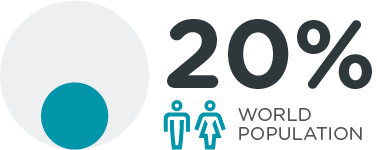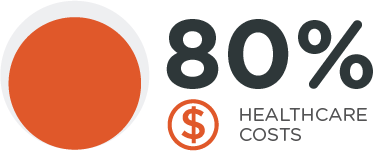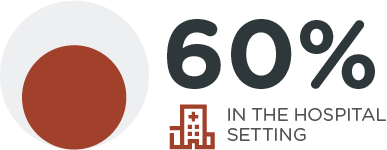Everyone is affected by chronic diseases
P2link’s founding premise is to increase chronic diseases patient quality of life, maintaining them at home safely while effectively contributing to lowering costs for insurance payers.
The world population is growing and aging. Therefore, the typology of diseases is changing. Chronic diseases are becoming more and more common through the combination of two main factors: the aging of the population and our greater capability to stop the once fatal diseases, and thereby turn them into chronic ones. Sixty percent of the cost of treating Chronic Heart Failure (CHF) and Chronic Obstructive Pulmonary Disease (COPD) is hospitalization.
Dr LEE Jong-Wook, former Director General of WHO
To start P2link is focusing on two main critical conditions Chronic Heart Failure (CHF)(1) and Chronic Obstructive Pulmonary Disease (COPD) (14).
Chronic Heart Failure (CHF)
CHF is a chronic, progressive condition in which the heart muscle is unable to pump enough blood through the heart to meet the body’s needs for blood and oxygen.(2)(Video)
The main manifestations of CHF are dyspnea and fatigue, limited exercise tolerance and fluid retention leading to pulmonary or splanchnic congestion and peripheral edemas. CHF incidence increases with age rising from approximately 20 per 1000, for people 65 to 69 years of age, to 80 per 1000 for people over 85 years of age.(3,4,5,6)
Mortality is high with a 50% rate within 5 years of diagnostic. Hospitalizations are frequent and patient hospitalized for CHF are at risk for all cause rehospitalization.(7,12,13)
CHF significantly decreases Health Related Quality of Life (HRQOL), especially in the area of physical functioning and vitality, furthermore a lack of improvement in HRQOL after hospital discharge is a powerful predictor of rehospitalization and mortality.(8,9,10,11,12)
Many conditions or comorbidities are associated with an increased propensity for structural heart diseases leading to CHF. The most important risk factor is hypertension; Diabetes Mellitus, obesity and insulin resistance are also important risk factors as for Metabolic Syndrome and Atherosclerotic Disease.
Chronic Obstructive Pulmonary Disease (COPD)
Chronic Obstructive Pulmonary disease (COPD)(14) is a common, preventable and treatable disease characterized by persistent respiratory symptoms and airflow limitation due to airway and/or alveolar abnormalities usually caused by significant exposure to noxious particles or gases. The most common respiratory symptoms include dyspnea (27), cough and/or sputum production. The main risk factor of COPD is tobacco smoking but other environmental exposures such as biomass fuel and air pollution may contribute.(25)
Some factors may predispose individuals to develop COPD such as genetic abnormalities abnormal lung development and accelerated aging.(17,18,19)
COPD is a leading cause of morbidity and mortality worldwide that induces an economic and social burden that is both substantial and increasing.(16)
Based on large epidemiological studies the global prevalence of the disease is at 11,7% the prevalence of COPD is expected to rise over the next 30 years.(20)
COPD is one of the most important causes of death in most countries ranking 3rd or 4th and has been mainly driven by the expanding epidemic of smoking.(15)
Morbidity from COPD may be affected by other concomitant chronic conditions like cardiovascular diseases, musculoskeletal impairment and diabetes mellitus. These conditions may significantly impair patient’s health status and are major drivers of hospitalizations and costs for patients with COPD.(23,24)
COPD is associated with significant economic burden, COPD exacerbations (26) account for the greatest proportion of the total COPD burden on the healthcare system. There is a direct relationship between the severity of COPD and the cost of care; particularly hospitalization and ambulatory oxygen costs soar as COPD severity increases.
The cost of treating
Sixty percent off the cost off treating Chronic Heart Failure (CHF) and Chronic Obstructive Pulmonary Disease (COPD) is hospitalization.
P2link’s whole action aims to prevent exacerbations of CHF and COPD and whenever they occur to avoid hospitalizations or to limit their duration and severity. P2link’s action aims to improve the quality of life through simple support and actions. P2link have build a service based on processes and technology that take into account the entire environment in which the patient lives and monitor constantly the main predictive factors of exacerbation.(28)
P2link’s solution is conceived to reduce the ongoing costs associated with those diseases, with an ambitious project and a philosophy based on the smart use of new technologies, predictive engine, human and social networks(29), and a blockchain repository.
References
CHF
1- http://www.onlinejacc.org/content/early/2017/04/20/j.jacc.2017.04.025?_ga=2.129282060.1094660836.1541760763-1728040870.1528212688
2- https://watchlearnlive.heart.org/CVML_Player.php?moduleSelect=hrtflr
3- https://www.ncbi.nlm.nih.gov/pmc/articles/PMC5408511
4- https://www.ncbi.nlm.nih.gov/pubmed/182994985 – https://www.ncbi.nlm.nih.gov/pubmed/15265849
6- https://www.ncbi.nlm.nih.gov/pubmed/12409541
7- https://www.ahajournals.org/doi/full/10.1161/CIR.0b013e318235eb4d?url_ver=Z39.88-2003&rfr_id=ori%3Arid%3Acrossref.org&rfr_dat=cr_pub%3Dpubmed
8- https://www.ncbi.nlm.nih.gov/pubmed/18310649
9- https://www.ncbi.nlm.nih.gov/pubmed/19181289
10- https://www.ncbi.nlm.nih.gov/pubmed/19879462
11- https://www.ncbi.nlm.nih.gov/pubmed/15956007
12- https://www.ncbi.nlm.nih.gov/pubmed/21262990
13- https://www.ncbi.nlm.nih.gov/pubmed/20964473
COPD
14- https://goldcopd.org/wp-content/uploads/2017/11/GOLD-2018-v6.0-FINAL-revised-20-Nov_WMS.pdf
15- https://www.ncbi.nlm.nih.gov/pubmed/23245604
16- https://www.ncbi.nlm.nih.gov/pubmed/23245607
17- https://www.ncbi.nlm.nih.gov/pubmed/20802169
18- https://www.ncbi.nlm.nih.gov/pubmed/19716966
19- https://www.ncbi.nlm.nih.gov/pubmed/20884729
20- https://www.ncbi.nlm.nih.gov/pmc/articles/PMC4693508/
21- http://erj.ersjournals.com/content/27/2/397.long
22- http://www.who.int/healthinfo/global_burden_disease/projections/en/
23- https://www.ncbi.nlm.nih.gov/pubmed/26208998
24- https://www.ncbi.nlm.nih.gov/pubmed/25675282
25- https://www.thoracic.org/patients/patient-resources/resources/copd today.pdf
26- https://www.thoracic.org/patients/patient-resources/resources/copd-exacerbation-ecopd.pdf
27- https://www.thoracic.org/patients/patient-resources/resources/breathlessness.pdf
28- http://erj.ersjournals.com/content/50/5/1701733




